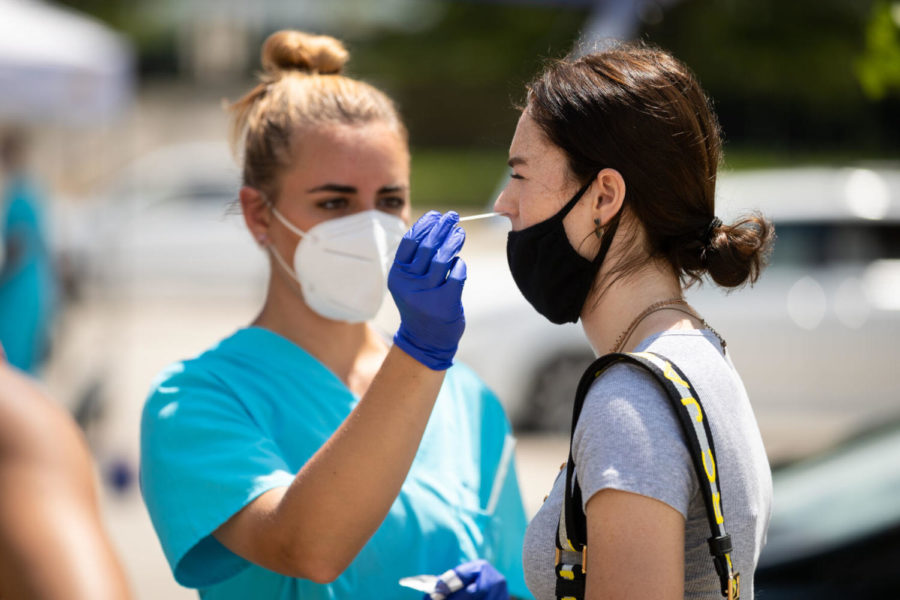COVID-19: Two years later
University of Kentucky strategic communications sophomore Maigan Williams gets tested for COVID-19 on Sunday, Aug. 16, 2020, at Kroger Field in Lexington, Kentucky. Photo by Michael Clubb | Staff
January 20, 2022
Over the past two years, the world has grappled to find its balance under the unpredictable conditions brought by COVID-19. This uninvited guest has left the world with devastating gifts that have altered life as we know it.
According to CNN, the first cases of the virus were reported as pneumonia in Wuhan, China, in December 2019. However, the first confirmed case on U.S. soil wasn’t until Jan. 21, 2020.
This virus eventually spread all over the world, forging a global pandemic. On March 11, 2020, the Centers for Disease Control and Prevention (CDC) declared that the virus was a pandemic, and UK issued a statement that classes were going online.
Whether a student or faculty member, no one is exempt from the changes of the pandemic, as adapting to these unforeseeable times reshaped social interactions and transformed everyday activities.
For freshman Elizabeth Dicken, online classes can be an overall stressful experience.
“I learn better face-to-face, like I have to sit in a classroom,” she said. “Trying to find the motivation to pay attention and learn on my own is really difficult.”
For others, such as freshman Paige Williams, online classes have caused mixed feelings because they can become tiring after a while.
“It felt good at first because it was like a little break,” Williams said. “But then it started to go on forever, so like you just want to get back in classes and in person.”
As a math instructor, calculus professor Jonathan Clark has experienced the difficulties of teaching in the midst of the pandemic, especially when students need to quarantine after being exposed to the virus.
“Things have gotten exponentially harder for students in particular,” Clark said. “There are a lot of classes, math in particular, where if you take that step out, the next step is now impossible to reach, creating an incredible risk for snowballing once students are behind.”
The pandemic forged more barriers between students and instructors, causing additional complications in the learning experience.
Due to the virus, many interactions have been virtual rather than in-person, which has changed the culture of communication between instructors and their students.
Although most classes at UK have gone back to in-person following the 2020 spring semester, there are still hybrid classes.
ISC professor Dr. Beth Barnes has seen how the pandemic has completely reworked her interactions with her students, as email has become the main form of contact.
“I used to get a fair amount of in-person visits to my office hours, but since the pandemic started, even once we went back to in-person classes, many students seem to prefer emailing instead,” Barnes said. “I don’t mind, because I want people to be comfortable, but I think those interactions are less useful for both students and me than being able to talk in person.”
Meanwhile, other professors have found that in-person classes have helped them learn more about their students.
Marketing professor Holly Hapke has found ways to connect with her students virtually; however, she prefers to have them in person. In order to connect with students, Hapke has used platforms such as Zoom, GroupMe and Discord.
“In my opinion, students’ nonverbal facial cues during class help connect,” Hapke said. “I really miss seeing students’ smiles.”
While professors have had to modify their courses, students have had to adjust to these alterations of their classes. By moving classes to online or hybrid formats, students such as senior Lizzie Watkins have struggled with online learning and have had to teach themselves the material in a way they understand.
On top of that, socially interacting with classmates and establishing relationships with others has raised complications as well.
“It was really hard to socialize, especially at the beginning of the pandemic,” Watkins said. “Now it’s gotten a bit better, but one of the biggest aspects in college is making friends, and it was quite difficult when there were no in-person events to go to.”
Looking back at the past couple years, circumstances have been transfigured as the ongoing pandemic has redesigned social interactions and overall communication between others.
































































































































































